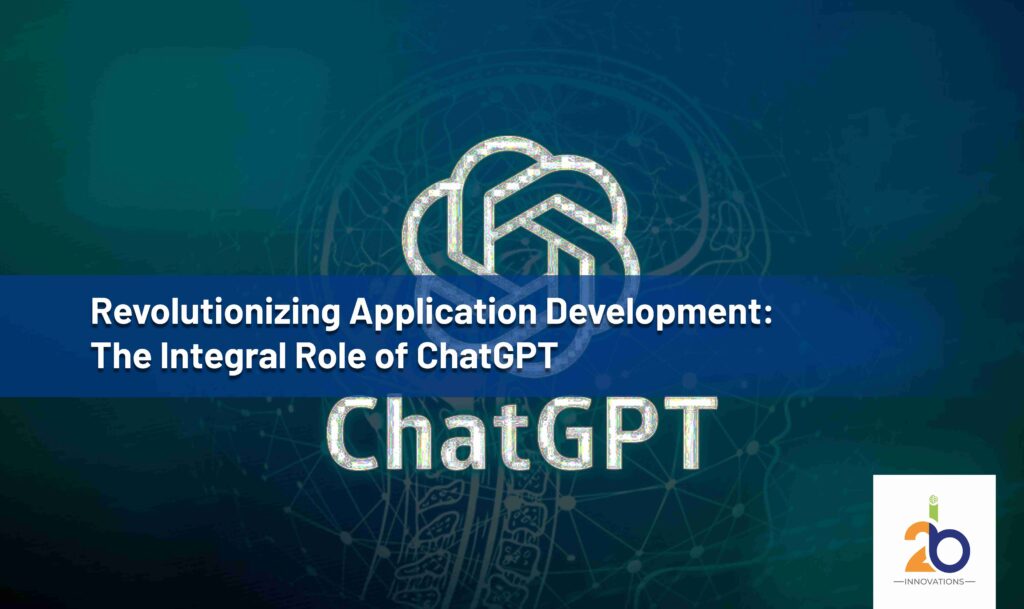
In a world where 3.6 billion people own smartphones and businesses rely on digital solutions more than ever, consider this: every second, approximately 1,500 new mobile applications are downloaded globally.
As our lives become increasingly intertwined with technology, the importance of application development has soared to unprecedented heights. It’s a world where innovation thrives, productivity soars, and creativity knows no bounds. But what’s the secret sauce behind this digital revolution?
Let’s dive into the pivotal role of ChatGPT in shaping the landscape of application development.
Understanding Application Development
Application development, often referred to as app development, is the process of designing, creating, and deploying software applications that run on various computing devices, such as computers, smartphones, tablets, and even embedded systems.
It encompasses a range of activities, including conceptualizing the application’s purpose, designing its user interface and functionality, writing the code, testing for quality and functionality, and finally, deploying and maintaining the application.
Key Aspects Of Application Development Include:
- Conceptualization:
This phase involves identifying the purpose and objectives of the application. It includes market research, defining user requirements, and outlining the application’s features and functionalities.
- Design:
In this stage, developers create the user interface (UI) and user experience (UX) design. They plan the application’s layout, navigation, and visual elements to ensure an intuitive and appealing user experience.
- Development:
Developers write the actual code that makes the application work. This involves programming in various languages and frameworks, depending on the platform and technology stack chosen for the project.
- Testing and Quality Assurance:
Rigorous testing is essential to identify and fix bugs, ensure the application functions as intended, and meets performance, security, and compatibility standards.
- Deployment:
Once the application is thoroughly tested and refined, it is deployed to the target platforms, such as app stores, web servers, or enterprise environments, making it available for users to download or access.
- Maintenance and Updates:
Continuous maintenance and updates are crucial to address issues, add new features, enhance security, and ensure compatibility with evolving technology.
Importance Of Application Development:
Application development is of paramount importance for both businesses and individuals in the modern world for several reasons:
- Enhanced Efficiency:
Applications streamline processes and automate tasks, increasing efficiency and productivity. For businesses, this means faster operations and cost savings, while individuals benefit from time-saving tools.
- Improved User Experiences:
Well-designed applications offer intuitive and user-friendly interfaces, enhancing user experiences. Businesses can build customer loyalty and engagement through user-centric applications.
- Market Reach:
Mobile apps and web applications provide a platform for businesses to reach a global audience. They enable companies to expand their market presence and access a broader customer base.
- Competitive Edge:
Staying competitive in today’s digital landscape often requires businesses to have a digital presence. Custom applications can provide a unique edge, offering specialized solutions tailored to specific needs.
- Data-driven Decision Making:
Applications collect valuable data that can be analyzed to make informed decisions, identify trends, and improve strategies. This data-driven approach is essential for business growth.
- Innovation and Creativity:
Application development fosters innovation, allowing individuals and organizations to create novel solutions to problems, from social networking to healthcare.
- Revenue Generation:
For businesses, applications can serve as revenue streams through direct sales, in-app purchases, advertising, or subscription models.
The Evolution of AI in Application Development
The evolution of artificial intelligence (AI) in application development has been a fascinating journey marked by significant milestones:
- Early AI Concepts (1950s-1960s):
AI research began in the mid-20th century, with pioneers like Alan Turing and John McCarthy laying the foundation for AI. Early applications of AI in development were basic rule-based systems and expert systems.
- Expert Systems (1970s-1980s):
The development of expert systems, which emulated human expertise in specific domains, marked a significant advancement. These systems found applications in medical diagnosis, finance, and manufacturing.
- Machine Learning (1990s-2000s):
Machine learning algorithms, particularly neural networks, gained prominence. This era saw AI being used for handwriting recognition, speech recognition, and recommendation systems, among others.
- Big Data and Deep Learning (2010s):
The proliferation of big data and the emergence of deep learning algorithms enabled AI to achieve remarkable feats in image recognition, natural language processing, and autonomous vehicles.
ChatGPT’s Emergence:
ChatGPT, a product of OpenAI, emerged as a significant milestone in the AI landscape:
- Introduction (June 2020):
OpenAI introduced the first version of ChatGPT, known as GPT-3, in June 2020. It immediately garnered attention for its impressive natural language understanding and generation capabilities.
- Initial Applications:
ChatGPT quickly found applications in various domains. It was used to develop chatbots and virtual assistants that provided human-like interactions, enhancing customer support and user engagement.
- Content Generation:
Content creators began leveraging ChatGPT to automate content generation. Blog posts, social media updates, and product descriptions were among the content types that ChatGPT could generate, saving time and effort for writers and marketers.
- Code Generation and Assistance:
Developers embraced ChatGPT for its ability to generate code snippets and assist with coding tasks. It became a valuable tool for speeding up software development and troubleshooting.
- Conversational Interfaces:
ChatGPT-powered conversational interfaces became a common feature in various applications. They offered users a more natural and interactive way to interact with software, from virtual shopping assistants to healthcare chatbots.
ChatGPT, introduced in 2020, marked a pivotal moment with its versatile applications in natural language understanding, content generation, code assistance, and conversational interfaces. Its ongoing development and integration into various industries continue to shape the future of AI in application development.
ChatGPT: A Game-Changer in Application Development
ChatGPT is a cutting-edge language model developed by OpenAI, designed to understand and generate human-like text. It functions as a versatile natural language processing tool, making it a game-changer in application development. It utilizes a deep neural network to analyze and generate text, making it adept at comprehending and generating human language.
Key Capabilities:
Natural Language Understanding:
ChatGPT’s advanced natural language understanding capabilities are a boon for developers. It can extract meaning from user input, enabling applications to understand and respond to text-based commands and queries effectively.
For instance, in a chatbot application, ChatGPT can comprehend user inquiries, allowing for more intuitive and interactive user experiences.
Code Generation:
One of ChatGPT’s remarkable capabilities is its ability to assist in generating code for applications. Developers can describe programming tasks in plain language, and ChatGPT can provide code snippets or even entire functions, saving time and reducing coding errors.
This feature is invaluable in expediting software development, especially for those who may not be proficient in coding.
Debugging And Testing:
ChatGPT can play a significant role in identifying and fixing issues in code. Developers can describe problems they are encountering, and ChatGPT can offer insights into potential solutions or debugging strategies.
It can help troubleshoot errors, optimize code, and enhance the overall quality of an application.
Real-Life Use Cases:
Content Generation:
ChatGPT’s content generation capabilities have been harnessed by content creators, marketers, and bloggers. It can assist in automatically generating blog posts, product descriptions, and social media content.
For instance, an e-commerce platform can use ChatGPT to create product descriptions for a large catalog of items, ensuring consistency and saving time.
Conversational Interfaces:
ChatGPT powers conversational interfaces in customer support applications. For example, a banking app can incorporate ChatGPT to provide users with quick and accurate responses to their inquiries, improving the overall customer experience.
Code Assistance:
In software development, ChatGPT is utilized to assist with code completion, offering suggestions as developers write code. Integrated into code editors, it can provide instant help with syntax and offer code examples to expedite the coding process.
Language Translation:
ChatGPT’s multilingual capabilities make it ideal for language translation applications. For instance, a travel app can use ChatGPT to translate text and provide travelers with real-time language assistance, enhancing their experiences in foreign countries.
Benefits Of Using ChatGPT In Application Development
In the rapidly evolving landscape of application development, ChatGPT has emerged as a powerful tool, providing developers with a myriad of advantages. Let’s delve into the key benefits:
Efficiency:
ChatGPT significantly accelerates the development process. Here’s how:
- Rapid Prototyping:
Developers can quickly create prototype applications by describing their ideas in natural language. ChatGPT interprets these descriptions and generates initial code snippets, saving valuable time in the early stages of development.
- Code Refinement:
When fine-tuning or optimizing code, ChatGPT can provide suggestions and even generate alternative code snippets. This not only speeds up the debugging process but also enhances the overall code quality.
- 24/7 Availability:
Unlike human developers who have working hours, ChatGPT is available around the clock. This means developers can receive assistance at any time, reducing project timelines.
Accessibility:
ChatGPT democratizes application development by making it accessible to a wider audience:
- No Coding Background Required:
ChatGPT allows individuals with limited or no coding experience to engage in application development. By conversing with ChatGPT, they can articulate their ideas and receive code implementations, breaking down barriers to entry.
- Inclusive Collaboration:
Teams with diverse skill sets can collaborate seamlessly. Non-technical team members can contribute to development discussions and gain insights from ChatGPT-generated code, fostering cross-functional cooperation.
- Language Flexibility:
ChatGPT understands multiple programming languages, eliminating language barriers and enabling developers from various linguistic backgrounds to collaborate effectively.
Accuracy:
ChatGPT enhances accuracy and quality in application development:
- Error Detection:
ChatGPT can identify potential errors or vulnerabilities in code, helping developers catch issues early in the development process. This proactive approach reduces the likelihood of critical errors in the final product.
- Consistency:
ChatGPT ensures code consistency by adhering to best practices and coding standards. This consistency not only improves code readability but also makes it easier to maintain and scale applications.
- Documentation:
ChatGPT can generate documentation for the code it produces, aiding in project documentation and knowledge transfer.
Cost Savings:
Using ChatGPT can lead to substantial cost savings in the following ways:
- Reduced Labor Costs:
With ChatGPT’s assistance, developers can accomplish tasks faster, reducing the number of man-hours required for a project. This translates into lower labor costs and potentially shorter project timelines.
- Minimized Training Expenses:
Training non-technical personnel in coding can be costly and time-consuming. ChatGPT eliminates the need for extensive training, allowing businesses to allocate resources more efficiently.
- Lower Error Correction Costs:
By identifying and preventing errors early, ChatGPT helps avoid costly post-launch bug fixes and maintenance.
Challenges And Ethical Considerations
As we explore the transformative potential of ChatGPT in application development, it’s essential to acknowledge and address certain challenges and ethical considerations that accompany this technology.
Biases in AI:
One of the foremost concerns when integrating ChatGPT into the development process is the potential for biases in the AI model.
ChatGPT, like many AI systems, learns from vast datasets sourced from the internet, which can contain inherent biases present in the data. These biases can manifest in various ways within applications developed using ChatGPT, including biased language, recommendations, or decisions.
Ethical Concerns:
- Reinforcing Prejudices:
Biased AI models can inadvertently perpetuate stereotypes, inequalities, or discriminatory practices in applications. For instance, if a biased language model generates content for a health application, it might offer advice or information that is not equally applicable or safe for all demographic groups.
- Unintentional Discrimination:
Biases in ChatGPT can lead to unintentional discrimination in various areas, such as hiring applications where the model may favor certain demographic groups over others.
Mitigation Strategies:
To mitigate these concerns, developers need to be vigilant and employ techniques like bias detection and correction. Additionally, using diverse and representative training data can help reduce inherent biases in the AI model.
Continuous monitoring and feedback loops in the development process can also play a pivotal role in minimizing biases.
Data Privacy:
Another critical ethical consideration is data privacy. In the course of using ChatGPT for application development, developers often need to input sensitive data. Ensuring the protection of this data is paramount.
Ethical Concerns:
- Data Breaches:
The mishandling or inadequate security measures can lead to data breaches, which can have severe consequences for users and organizations.
- Informed Consent:
Developers must ensure that users are adequately informed about the data collection and usage practices within their applications. Users should have the option to consent or opt out of data sharing.
Mitigation Strategies:
To address data privacy concerns:
- Encryption:
Employ strong encryption protocols to protect data during storage and transmission.
- Data Minimization:
Collect only the data necessary for the application’s functionality and anonymize or pseudonymous personal information.
- Transparency:
Be transparent with users about data usage, and obtain explicit consent when necessary.
The Future of Application Development with ChatGPT
In recent years, ChatGPT has emerged as a powerful tool for natural language processing, revolutionizing the way we interact with computers and applications.
As we look ahead, the future of application development with ChatGPT promises to be both exciting and transformative. Let’s have a look at the future of app development with AI in details:
Emerging Trends in Application Development with ChatGPT:
- Conversational Interfaces:
The most prominent trend is the proliferation of conversational interfaces powered by ChatGPT. Developers are integrating chatbots and virtual assistants into a wide range of applications, from customer service portals to healthcare apps. These conversational interfaces enhance user engagement, streamline interactions, and provide personalized experiences.
- Content Generation:
ChatGPT’s ability to generate human-like text is being harnessed for content generation. Content creators and marketers are leveraging it to automate the creation of blog posts, product descriptions, and social media updates. This not only saves time but also ensures consistent, high-quality content.
- Personalization:
ChatGPT’s natural language understanding capabilities enable applications to offer personalized recommendations and responses. E-commerce platforms, news aggregators, and recommendation engines can use ChatGPT to understand user preferences and tailor their content or product suggestions accordingly.
- Code Generation:
For software development, ChatGPT is being used to generate code snippets, simplifying and speeding up the coding process. Developers can describe a task in plain English, and ChatGPT can provide code solutions, making development more accessible to non-programmers as well.
- Multilingual Applications:
ChatGPT’s multilingual capabilities are making applications more globally accessible. Developers can easily incorporate language translation and localization features, allowing their apps to cater to a broader user base.
Integration with Other Technologies:
- Augmented Reality (AR):
Integrating ChatGPT with AR applications opens up a world of possibilities. For instance, in AR tourism apps, users could have virtual tour guides powered by ChatGPT, providing information and stories about historical sites as users explore them in the real world. ChatGPT can also enhance user interfaces in AR applications by enabling natural language voice commands and interactions.
- Blockchain:
The combination of ChatGPT and blockchain technology can improve the security and transparency of various applications. Smart contracts powered by ChatGPT can facilitate automated, trustless agreements, while ChatGPT can also assist in natural language querying of blockchain data, making it more accessible to non-technical users.
- Healthcare:
In the healthcare sector, ChatGPT’s integration with AR can assist surgeons with real-time, voice-controlled guidance during complex procedures. Additionally, combining ChatGPT with blockchain can enhance the security of electronic health records, ensuring that sensitive patient data remains private and tamper-proof.
- Education:
ChatGPT’s role in education applications can be enriched by AR. Students could have AI-powered virtual tutors in AR classrooms, providing instant explanations and personalized learning experiences. Blockchain can be used for secure credential verification and academic records management.
Conclusion
In simple terms, ChatGPT is a pivotal tool in modern application development, offering natural language understanding, code generation, and debugging assistance. Its significance lies in simplifying development processes and expanding opportunities for businesses and individuals.
We encourage embracing ChatGPT’s potential to enhance user experiences, automate tasks, and stay at the forefront of innovation in application development. Embrace ChatGPT for efficiency, creativity, and growth in the digital era.



